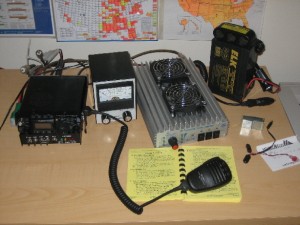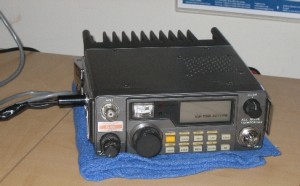 It was time for me to break my FT-817 out of the closet for a bit. First I had to justify continuing to own the radio that generally resides in a tupperware box, and second I had to send my Icom 756ProII off to service to repair the CAT section of the radio. I decided that I would spend this QRP time on the air running battery power and operating SSB instead of CW or PSK31.
It was time for me to break my FT-817 out of the closet for a bit. First I had to justify continuing to own the radio that generally resides in a tupperware box, and second I had to send my Icom 756ProII off to service to repair the CAT section of the radio. I decided that I would spend this QRP time on the air running battery power and operating SSB instead of CW or PSK31.
I setup the radio and just used my normal antennas at the house (End Fed 10m/15m/20m antennas, G5RV, 6 meter stacked loops). I did put my 100 watt amplifier in line just in case I really had to work someone (like a new DXCC) but other than testing it on a couple of QSOs, I didn’t make use of it. I used the LDG Z-11 Pro tuner when needed on the G5RV. I also used my FT-690RII 6 meter rig that runs 10watts to make a QSO during a band opening. (Pictured below)
This time, instead of holding myself to a set number of QSOs, I just had fun running the radio and tried to do my best. With the solar conditions continuing to be pretty unchanged and blah (SF=69 the entire time) I knew things would be challenging. I still made QSOs with EA5, DA, SP9, OZ, and Kansas and California on 20 meter SSB, Tennessee on 40 meter SSB, and Louisiana (EL39) on 6 meter SSB (10 total QRP QSOs).
It was a great time to review the operation of the radio, and put the 8 amp gel cell to use. I knew that the radio would perform well QRP operating CW and PSK31, since I spent a month doing that in 2007 and have periodically operated QRP on those modes as well. We all know that CW has an advantage over SSB when QRP, and I thought recall beating my head against the wall trying to get folks to answer me when I spent a month operating the radio before.
Ten SSB QSOs aren’t bad for the two or so weeks that I spent with the radio this time. Here are a few tips to remember if you want to give it a try yourself.
Don’t forget 80/60/40. Making SSB QSOs there during the day when the band isn’t crowded, and the noise level is potentially lower can be a lot of fun. Plus there are tons of nets on 80/40 that give you an opportunity to get plenty of reports.
Don’t be afraid to have or use a pilot station on the air. What I mean is that for my 6 meter QSO, Doug was QRO on the 9 element antenna, and he asked people to stand by and listen for me. 6 was also a big surprise at how much work you could do with just a 10 watt radio there when the band opened.
I watched the DX cluster carefully and would try to work some of the known big guns with big antennas that are on the air everyday. Trying to punch through a pile up of any sort would be less than successful…Unless they take a break and ask for QRP stations, which some will do.
I was patient and called stations with decent signals that I could hear. After all, if I had trouble hearing them or there was QSB, I knew I was in for a long road (or an empty spot in the logbook).
Anyway, thats just a couple of random thoughts that I thought I would share for those who are interested. I would love to hear any comments or questions. Anyone want to use the radio for their own QRP experiments? 73.

